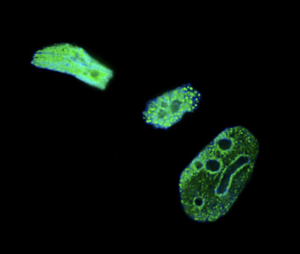 NUT midline carcinoma (NMC) is a rare, genetically defined, aggressive human cancer defined by rearrangements of the gene NUT. This is probably the most aggressive solid tumor known with a median survival of 6.5 months, though there is some evidence to suggest that NUT-variant tumors carry a better prognosis. In the majority (approximately 75%) of NMCs most of the coding sequence of NUT on chromosome 15q14 is fused to BRD4 or BRD3, creating chimeric genes that encode BRD-NUT fusion proteins. In the remaining cases, NUT is fused to an unknown partner gene; these tumors are termed NUT-variant. Diagnosis of NMC is made by demonstration of expression of the NUT-fusion protein using a monoclonal antibody to NUT for immunohistochemistry, and confirmation of the fusion (BRD-NUT or NUT-variant) by fluorescent in situ hybridization. Because the reagents and expertise required to diagnose NMC are not available in most laboratories, and the incomplete awareness of this disease, NMC is frequently undiagnosed or misdiagnosed, and its actual prevalence is unknown. We are the only known laboratory capable of diagnosing NMC routinely, thus most cases worldwide are sent here for diagnosis and consulted with us for management. We currently see 15-20 cases annually.
NUT midline carcinoma (NMC) is a rare, genetically defined, aggressive human cancer defined by rearrangements of the gene NUT. This is probably the most aggressive solid tumor known with a median survival of 6.5 months, though there is some evidence to suggest that NUT-variant tumors carry a better prognosis. In the majority (approximately 75%) of NMCs most of the coding sequence of NUT on chromosome 15q14 is fused to BRD4 or BRD3, creating chimeric genes that encode BRD-NUT fusion proteins. In the remaining cases, NUT is fused to an unknown partner gene; these tumors are termed NUT-variant. Diagnosis of NMC is made by demonstration of expression of the NUT-fusion protein using a monoclonal antibody to NUT for immunohistochemistry, and confirmation of the fusion (BRD-NUT or NUT-variant) by fluorescent in situ hybridization. Because the reagents and expertise required to diagnose NMC are not available in most laboratories, and the incomplete awareness of this disease, NMC is frequently undiagnosed or misdiagnosed, and its actual prevalence is unknown. We are the only known laboratory capable of diagnosing NMC routinely, thus most cases worldwide are sent here for diagnosis and consulted with us for management. We currently see 15-20 cases annually.
NMC does not arise from any specific tissue type or organ. It presents as a poorly differentiated carcinoma originating from midline locations such as the head, neck or mediastinum. Although rare, NMCs occur throughout life and advanced local disease is frequently accompanied by distant metastases. Clinical knowledge of the treatment and response of NMC is limited to case reports and small series. Not uncommonly an initial response to chemotherapy is observed, but typically this is followed by rapid recurrence and death. Thus, there remains no effective treatment or guidelines for the management of NMC. Current approaches to treatment are based on discussions amongst a few oncologists with limited experience treating this disease.
The BRD4 and BRD3 moieties of BRD-NUT fusion oncoproteins contain twin bromodomains, which in a normal context bind acetylated histones of both mitotic and interphase chromatin. The function of BRD4 appears to activate transcription of early G1 genes following mitosis via its interaction with the transcriptional elongation complex, P-TEFb. While the function of NUT is unknown, studies have shown that when fused to BRD, it appears to be tethered to chromatin by the BRD bromodomains. The BRD-NUT transgene functions to block cellular differentiation and promote uncontrolled growth of carcinoma cells. When BRD-NUT expression is silenced in culture, human NMC cells dramatically differentiate into mature squamous cells, and proliferation stops abruptly. Taking advantage of this unique biology, we are currently engaged in investigating targeted agents, with some promising leads.